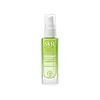What's inside
What's inside
 Key Ingredients
Key Ingredients

 Benefits
Benefits

 Concerns
Concerns

 Ingredients Side-by-side
Ingredients Side-by-side

Water
Skin ConditioningGluconolactone
Skin ConditioningMethyl Methacrylate Crosspolymer
Dicaprylyl Carbonate
EmollientNiacinamide
SmoothingPropanediol
SolventSodium Hydroxide
BufferingDimethicone
EmollientGlycerin
HumectantBiosaccharide Gum-4
Skin ConditioningCamellia Japonica Flower Extract
EmollientCetearyl Dimethicone Crosspolymer
Crithmum Maritimum Extract
Skin ConditioningPentaerythrityl Tetra-Di-T-Butyl Hydroxyhydrocinnamate
AntioxidantSclerotium Gum
Emulsion StabilisingSalicylic Acid
MaskingSodium Hyaluronate
HumectantTocopherol
Antioxidant1,2-Hexanediol
Skin ConditioningCaprylic/Capric Triglyceride
MaskingCetearyl Alcohol
EmollientGlyceryl Stearate
EmollientHydrogenated Vegetable Oil
EmollientPEG-100 Stearate
Coco-Glucoside
CleansingParfum
MaskingWater, Gluconolactone, Methyl Methacrylate Crosspolymer, Dicaprylyl Carbonate, Niacinamide, Propanediol, Sodium Hydroxide, Dimethicone, Glycerin, Biosaccharide Gum-4, Camellia Japonica Flower Extract, Cetearyl Dimethicone Crosspolymer, Crithmum Maritimum Extract, Pentaerythrityl Tetra-Di-T-Butyl Hydroxyhydrocinnamate, Sclerotium Gum, Salicylic Acid, Sodium Hyaluronate, Tocopherol, 1,2-Hexanediol, Caprylic/Capric Triglyceride, Cetearyl Alcohol, Glyceryl Stearate, Hydrogenated Vegetable Oil, PEG-100 Stearate, Coco-Glucoside, Parfum
Water
Skin ConditioningCyclopentasiloxane
EmollientGlycolic Acid
BufferingCetearyl Ethylhexanoate
EmollientCaprylic/Capric Triglyceride
MaskingCyclohexasiloxane
EmollientPropylene Glycol
HumectantLauryl PEG/PPG-18/18 Methicone
Skin ConditioningPentylene Glycol
Skin ConditioningAmmonium Hydroxide
BufferingSodium Chloride
MaskingAloe Barbadensis Leaf Juice
Skin ConditioningSodium PCA
HumectantAscorbyl Glucoside
AntioxidantUrea
BufferingBisabolol
MaskingHydrolyzed Collagen
EmollientEryngium Maritimum Callus Culture Filtrate
Skin ConditioningAllantoin
Skin ConditioningErgothioneine
AntioxidantDimethiconol
EmollientXanthan Gum
EmulsifyingTocopheryl Acetate
AntioxidantDipropylene Glycol
HumectantLecithin
EmollientAlcohol
AntimicrobialPolysorbate 20
EmulsifyingSodium Lactate
BufferingLimonene
PerfumingPropylparaben
PreservativeButylparaben
MaskingPhenoxyethanol
PreservativeIsobutylparaben
AntimicrobialMethylparaben
PreservativeEthylparaben
PreservativeParfum
MaskingBenzyl Salicylate
PerfumingHexyl Cinnamal
PerfumingWater, Cyclopentasiloxane, Glycolic Acid, Cetearyl Ethylhexanoate, Caprylic/Capric Triglyceride, Cyclohexasiloxane, Propylene Glycol, Lauryl PEG/PPG-18/18 Methicone, Pentylene Glycol, Ammonium Hydroxide, Sodium Chloride, Aloe Barbadensis Leaf Juice, Sodium PCA, Ascorbyl Glucoside, Urea, Bisabolol, Hydrolyzed Collagen, Eryngium Maritimum Callus Culture Filtrate, Allantoin, Ergothioneine, Dimethiconol, Xanthan Gum, Tocopheryl Acetate, Dipropylene Glycol, Lecithin, Alcohol, Polysorbate 20, Sodium Lactate, Limonene, Propylparaben, Butylparaben, Phenoxyethanol, Isobutylparaben, Methylparaben, Ethylparaben, Parfum, Benzyl Salicylate, Hexyl Cinnamal
 Reviews
Reviews

Ingredients Explained
These ingredients are found in both products.
Ingredients higher up in an ingredient list are typically present in a larger amount.
This ingredient is an emollient, solvent, and texture enhancer. It is considered a skin-softener by helping the skin prevent moisture loss.
It helps thicken a product's formula and makes it easier to spread by dissolving clumping compounds.
Caprylic Triglyceride is made by combining glycerin with coconut oil, forming a clear liquid.
While there is an assumption Caprylic Triglyceride can clog pores due to it being derived from coconut oil, there is no research supporting this.
Learn more about Caprylic/Capric TriglycerideParfum is a catch-all term for an ingredient or more that is used to give a scent to products.
Also called "fragrance", this ingredient can be a blend of hundreds of chemicals or plant oils. This means every product with "fragrance" or "parfum" in the ingredients list is a different mixture.
For instance, Habanolide is a proprietary trade name for a specific aroma chemical. When used as a fragrance ingredient in cosmetics, most aroma chemicals fall under the broad labeling category of “FRAGRANCE” or “PARFUM” according to EU and US regulations.
The term 'parfum' or 'fragrance' is not regulated in many countries. In many cases, it is up to the brand to define this term.
For instance, many brands choose to label themselves as "fragrance-free" because they are not using synthetic fragrances. However, their products may still contain ingredients such as essential oils that are considered a fragrance by INCI standards.
One example is Calendula flower extract. Calendula is an essential oil that still imparts a scent or 'fragrance'.
Depending on the blend, the ingredients in the mixture can cause allergies and sensitivities on the skin. Some ingredients that are known EU allergens include linalool and citronellol.
Parfum can also be used to mask or cover an unpleasant scent.
The bottom line is: not all fragrances/parfum/ingredients are created equally. If you are worried about fragrances, we recommend taking a closer look at an ingredient. And of course, we always recommend speaking with a professional.
Learn more about ParfumWater. It's the most common cosmetic ingredient of all. You'll usually see it at the top of ingredient lists, meaning that it makes up the largest part of the product.
So why is it so popular? Water most often acts as a solvent - this means that it helps dissolve other ingredients into the formulation.
You'll also recognize water as that liquid we all need to stay alive. If you see this, drink a glass of water. Stay hydrated!
Learn more about Water